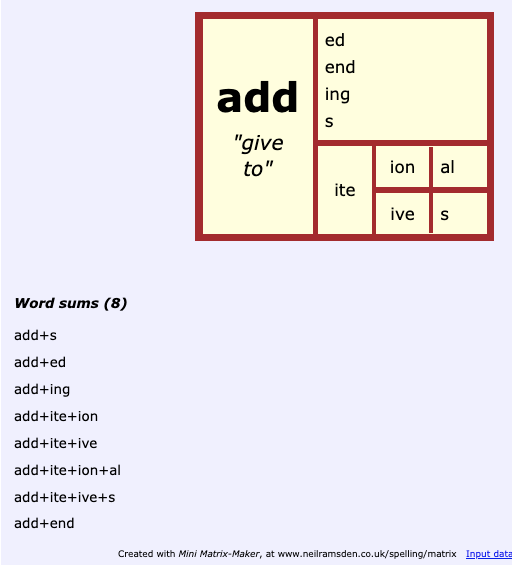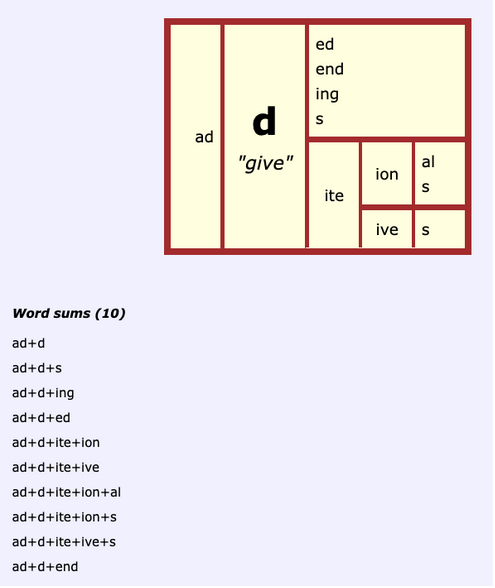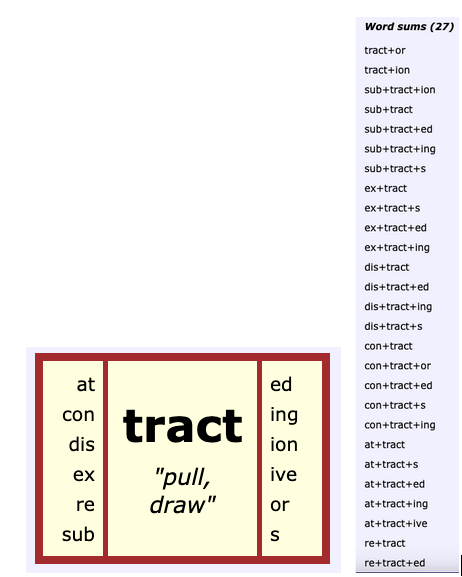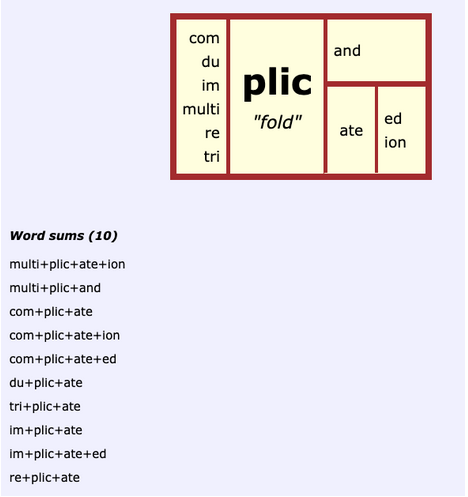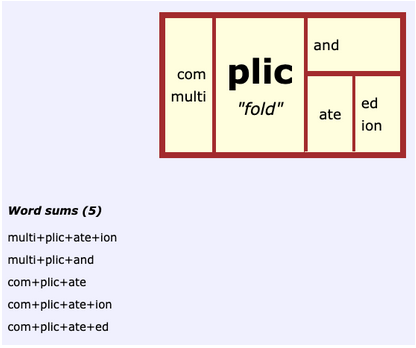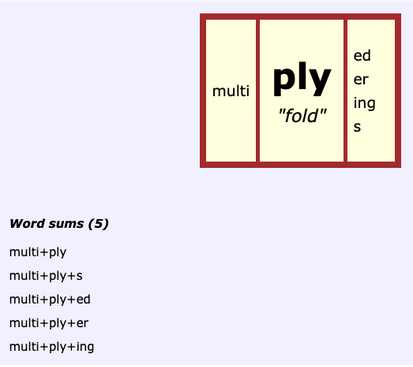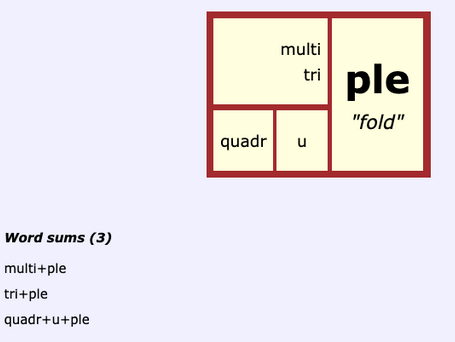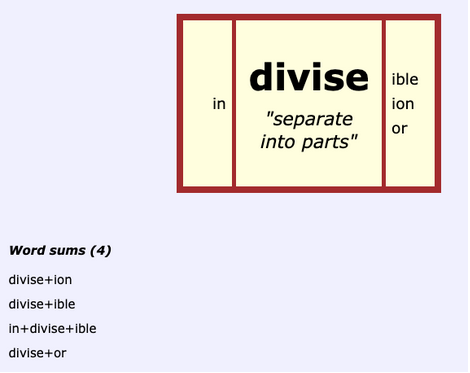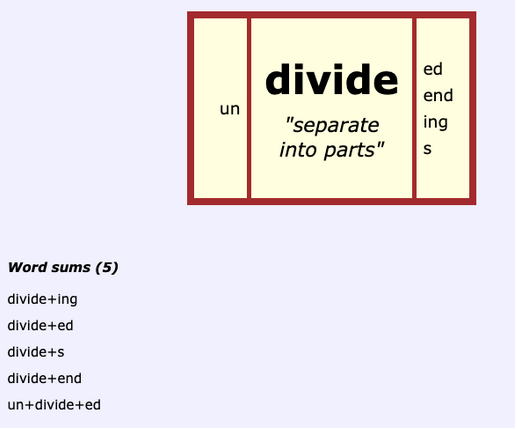I originally put this information together for a fourth grade teacher that I was mentoring at the time. I thought that if she understood these words beyond a dictionary definition, she could find ways to incorporate that understanding into her teaching. I went beyond the basics with this information so the teacher could make a professional decision about what to include in her teaching.
Addition –
We have evidence of this word existing in English as far back as the late 14th century. At this time it meant “action of adding numbers.” Prior to that it was in Old French (early 1400) spelled as adition and meant “increase, augmentation.” Even earlier than that (1300) it was in Latin and spelled as additionem and meant “add to, join, attach.”
Before the printing press was invented, spelling was similar place to place, but certainly not consistent. For example, in Middle English, this word was spelled as addissyoun and also as addycyoun! Those are only two of many variations.
A deeper dive that you may or may not wish to share with students …
Ultimately it comes from the Latin verb dare meaning “give.” This is not the modern word ‘dare’ as in I dare you to do something. This would have been pronounced as ‘dar’ (as in darling) +’ey’ (as in they). The thing about this is that the <are> on the Latin word dare is a Latin suffix and can be removed! That means that what came into English is the single letter base <d>! We never see a single letter base on its own. It is always attached to a prefix or suffix. That’s why it’s called a bound base. So what that means is that the structure of the word ‘addition’ is <ad + d + ite + ion>! The prefix <ad-> is seen on many words like adverb, adjective, advocate, adjacent. It carries the sense of “to.” In this word, the base means “give,” so the word means “give to.” That makes sense when we think of what addition is. The suffixes <-ite> and <-ion> are often used together and the final <-ion> indicates this is a noun.
If you’re wondering where else we see this single letter base <d>, one word that your students will know is the word ‘condiment.’ The structure of this word is <con + d + i + ment>. The prefix <con-> has a sense of “together,” the <d> means “give,” the <i> is a connecting vowel, and the <-ment> is a suffix indicating this is a noun. Condiments are a variety of things we put together with our food (ketchup, mustard, relish, etc.).
Another word is ‘mandate.’ The structure of this word is <man + d + ate>. The first base <mane> means “hand” (think manicure “professional care of the hand”, manuscript “written by hand,” and manual “done or used by hand”). The second base <d> means “give” and the suffix <-ate> indicates this can function as either a noun or a verb. This word means a judicial or legal order but we can think of it literally meaning “give into one’s hands.”
Yet another word is ‘tradition.’ The structure is <tra + d + ite + ion>. The prefix <tra-> is a shortened form of <trans-> meaning “over.” The base <d> means “give.” The suffixes <-ite> and <-ion> indicate this word is a noun. The idea of a tradition is that it is something that is “given over” from one generation to the next.
So, what to tell students?
There are several ways to share some of this with your students, and only you can make the best decision about which is most appropriate!
1) You could say that the base is <add> and have them help you think of words built off <add>. Then show them the following matrix and see if they recognize the words they suggested.
2) You could show them the structure of <add> and connect the <d> base to words they know such as condiment and tradition, but show the matrix that is totally related to math. The advantage of this is that they will be aware of the <ad> prefix and might begin to recognize it in other words.
3) You could show them the following matrix, although it might be better to begin with one or both of the others. YOU, however, will no doubt be intrigued by the words included here.
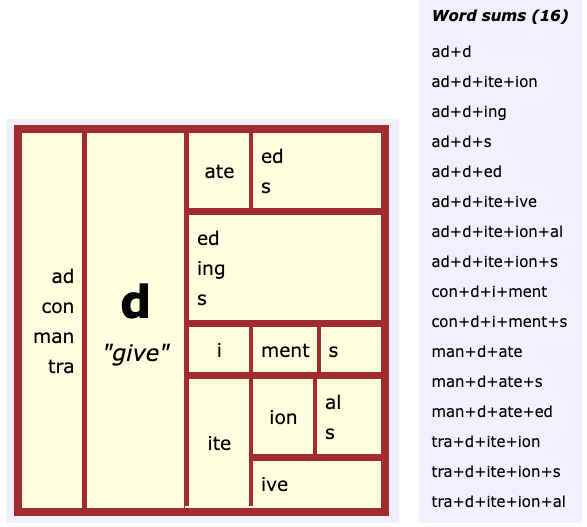
Subtraction-
We have evidence of this word existing in English as far back as 1400. At that time it was used to mean “withdrawal, removal.” It wasn’t until the early 1500’s that it was used as a mathematical term. Before it appeared in English, it was in Late Latin and spelled subtractionem “a drawing back, a taking away.” In earlier Latin it was subtrahere “to pull away, draw off.”
The structure of this word is <sub + tract + ion>. The prefix <sub-> has a sense of “from under,” the base <tract> means “pull, draw,” and the suffix <-ion> indicates this is a noun. The idea that we pull or draw a small number from “under” a bigger number is clear in the way we write a subtraction problem, lining up by place value.
There are many words that share this base that also share its sense and meaning.
tractor – something that pulls.
distract – when one’s attention is pulled away from something.
attract – One’s attention is drawn or pulled toward someone or something.
extract – something is withdrawn or pulled out. (flavorings in cooking, water from a rug)
retract – something is withdrawn or pulled back. (a statement, an awning)
contractor – someone who pulls a project together and makes sure all parts are completed.
Here’s a matrix with <tract> as the base that includes the above words.
In case you are wondering about the word ‘subtrahend,’ I will once again point out that the furthest back relative of this word was the Latin word subtrahere “to pull away, draw off.” If we replace the Latin suffix <-ere> with the modern English suffix <-end>, we’ll have the word ‘subtrahend!’ In modern English, subtraction and subtrahend don’t share a base so they can’t be on the same matrix. You can tell the students that they share a great grandparent! Even in the Oxford English Dictionary, I was unable to find any other words with a <trah> base. Most of the words besides ‘subtrahend’ that derive from subtrahere have a <tract> base.
Multiplication-
We have evidence of this word existing in English as far back as the mid-14th century. At that time it meant “any increase in size, number, or amount; act or process of increasing in number.” Earlier, in the 12th century it existed in Old French as multiplicacion and meant “duplication, multiplicity.” Earlier yet, it came from Latin multiplicare “to multiply, increase.” As you may be noticing, the spelling of this word is not much different than it was in Latin! If we remove the Latin suffix <-are> and replace it with the modern English suffixes <-ate> and <-ion>, we will have <multiplication → multi + plic + ate + ion>. The prefix <multi-> has a sense of “many,” the base <plic> means “folds,” and the suffixes <-ate> and <-ion>, often used together, indicate this word is a noun. Well, it is the final suffix that is indicating this is a noun. When <ate> is final, it is usually indicating the word is a verb (illustrate / illustration), although as we saw in the word ‘mandate’ it can indicate a noun as well.
Think of the words duplicate and triplicate. Their structures would be <du + plic + ate> and <tri + plic + ate>. The sense comes from the idea that something in triplicate is threefold. Not necessarily in the sense that it has been actually folded three times, but rather that it is as if it was replicated three times. Oooh! Look at the word ‘replicate!’ <re + plic + ate>! I’m also seeing that complicate and implicate share this same base as well!
replicate – repeat – as if folded over for an exact copy
complicate – folded together, confused, intricate.
implicate – act of entangling. Inference drawn from what is observed.
With your students, you may want to stick to words you know they know. Here is a simpler matrix, comparing the spelling of ‘multiplication’ to ‘complication.’ You’ll notice that the word ‘multiplicand’ is there. The <-end> suffix we saw in addend and subtrahend is an <-and> in this word.
But what about multiply?
The word ‘multiply’ has existed in English since the 12th century when it was spelled as multeplien and meant “to cause to become many; cause to increase in number or quantity.” As with ‘multiplication’ this word comes from Latin multiplicare. But further back, it comes from Latin multiplex “having many folds.” There are a few words that share the base <ply> meaning “fold.”
multiply – many folds
reply – fold back (conversation)
imply – entangle and involve something unstated
Looking at the words with the <ply> base gives you a perfect opportunity to talk about when we do and when we don’t toggle that final <y> to an <i> when adding the suffix!
Here’s a matrix focused only on words directly related to multiply. Again you have an opportunity to look at the <y> to <i> toggling convention.
But what about multiple?
The word ‘multiple’ first entered English in the 1640’s. The structure of this word is <multi + ple>. The base <ple> is from Latin multiplus and means “fold.” How about that! So the words multiplication, multiply, and multiple all share the literal meaning of “many folds.” Because they have differently spelled bases, they can’t appear on the same matrix. Here’s one for <ple>.
Division –
The word ‘division’ has existed in English since the late 14th century. At that time it was spelled divisioun and meant “act of separating into parts, portions, or shares.” Prior to entering English, it was in Old French and Latin before that. When it was in Latin, it was the verb dividere which meant “to force apart, distribute.”
As is often the case with Latin verbs, two modern English bases have derived from the same Latin verb: <divide> and <divise>. The second base here (<divise>) is a bound base. We don’t see it as a word on its own. It is always bound to either a prefix or a suffix. Because they derived from the same Latin verb, they have the same meaning, “separate, break up, share, distribute.” These two bases from the same Latin verb are sometimes referred to as twin bases (I always told my students to think of them as fraternal twins who may not look alike but came from the same parent).
Here is a matrix for each. In the first one you will note the opportunity to replace the final <e> on the base when you are adding a vowel suffix. There is another great opportunity to talk about the word ‘indivisible’ which is included in the Pledge of Allegiance.
In the second matrix you’ll see the suffix <-end> to form the word ‘dividend.’ This matrix also gives you the opportunity to talk about the common practice of replacing the final <e> on a base when adding a vowel suffix (suffix that begins with a vowel).
Resources used –
Etymonline
Oxford English Dictionary online
Neil Ramsden’s Mini Matrix Maker

